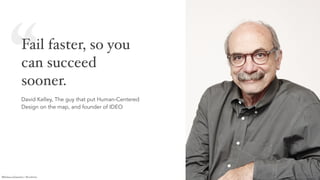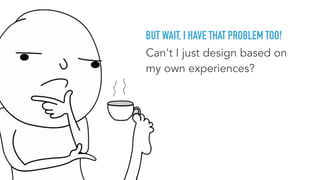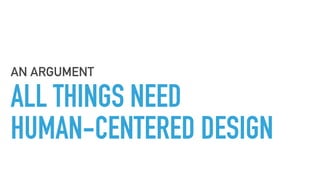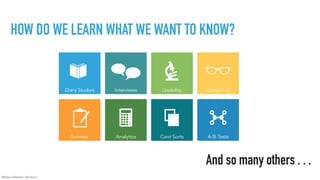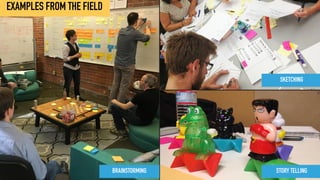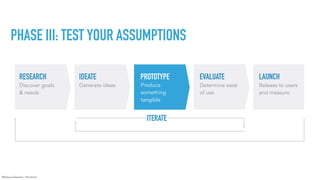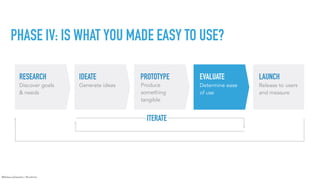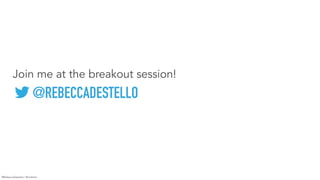Intro to Human Centered Design
- 1. DESIGNING WITH THE USER IN MIND AN INTRODUCTION TO @RebeccaDestello Affiliate Lecturer, Human Centered Design & Engineering at the University of Washington and UX Researcher, Facebook HUMAN-CENTERED DESIGN
- 2. @RebeccaDestello | #hcdintro Who is this lady, and why should I listen to her? A FAIR QUESTION...
- 3. @RebeccaDestello | #hcdintro Group Health Nordstrom University of Washington Atlas Informatics Anthro-Tech Facebook UX Consultant, 2007 Senior UX Researcher, 2011 Affiliate Lecturer, 2012 - present Manager Research & Insights, 2015 Director User Research, 2014 UX Research, 2017 - present MY BACKGROUND
- 4. @RebeccaDestello | #hcdintro HUMAN-CENTERED DESIGN SO, WHAT IS THIS THING YOU CALL
- 5. @RebeccaDestello | #hcdintro HUMAN-CENTERED DESIGN IS A FRAMEWORK RESEARCH Discover goals & needs IDEATE Generate ideas PROTOTYPE EVALUATE Determine ease of use LAUNCH Release to users and measure Produce something tangible ITERATE
- 6. @RebeccaDestello | #hcdintro TRY GOOGLING "HUMAN-CENTERED DESIGN"
- 7. @RebeccaDestello | #hcdintro Fail faster, so you can succeed sooner. David Kelley, The guy that put Human-Centered Design on the map, and founder of IDEO https://events.umich.edu/event/50717
- 8. @RebeccaDestello | #hcdintro TL;DR: HUMAN-CENTERED DESIGN IS UNDERSTANDING USER PROBLEMS AND THEN SOLVING THEM
- 9. @RebeccaDestello | #hcdintro Can't I just design based on my own experiences? BUT WAIT, I HAVE THAT PROBLEM TOO!
- 10. @RebeccaDestello | #hcdintro Merely being the victim of a particular problem does not automatically bestow on one the power to see its solution. Alan Cooper, Smart guy and all-around design badass who among a million other things also wrote “The Inmates Are Running the Asylum” https://en.wikipedia.org/wiki/Alan_Cooper
- 11. @RebeccaDestello | #hcdintro Is Homer Simpson the "Average American"? A DEBATABLE QUESTION http://www.chicagotribune.com/news/local/breaking/ct-homer-simpson-live-pizza-debate-met-0517-20160516-story.html
- 12. @RebeccaDestello | #hcdintro https://www.youtube.com/watch?v=U9IV50KiiMI
- 13. ALL THINGS NEED HUMAN-CENTERED DESIGN AN ARGUMENT
- 14. @RebeccaDestello | #TIDEconference@RebeccaDestello | #hcdintro REMOTE CONTROL? EVER TRIED TO USE A https://unitedfiber.com/remote-guides/
- 15. @RebeccaDestello | #TIDEconference@RebeccaDestello | #hcdintro https://unitedfiber.com/remote-guides/ GET TO THE GROUND FLOOR? EVER TRIED TO
- 16. @RebeccaDestello | #TIDEconference@RebeccaDestello | #hcdintro DEFROST CHICKEN? EVER DARED TO https://www.seriouseats.com/2017/07/how-to-steam-vegetables-in-the-microwave.html
- 17. @RebeccaDestello | #TIDEconference@RebeccaDestello | #hcdintro CHANGE THE TIME ON YOUR CAR DASHBOARD? EVER TRIED TO http://www.thetruthaboutcars.com/tag/infotainment/
- 18. @RebeccaDestello | #TIDEconference@RebeccaDestello | #hcdintro Design is not what it looks and feels like. Design is how it works. Steve Jobs, Some famous guy who invented some stuff https://www.theverge.com/2011/10/27/2517152/book-review-steve-jobs-by-walter-isaacson
- 19. @RebeccaDestello | #hcdintro Because it focuses your work on the user and roots your decisions in data. OKAY, BUT WHY USE A FRAMEWORK?
- 20. @RebeccaDestello | #TIDEconference@RebeccaDestello | #hcdintro THE HCD FRAMEWORK HELPS YOU Know where to begin More reliable than intuition Reminds you to continuously improve Keep the user at the center your decisions
- 21. @RebeccaDestello | #hcdintro A designer's expertise lies not in the thing they are designing, their expertise lies in knowing how to apply a framework for design. Somebody really smart
- 22. PHASE 1: RESEARCH LEARN ABOUT YOUR USERS
- 23. @RebeccaDestello | #hcdintro PHASE I: RESEARCH RESEARCH Discover goals & needs IDEATE Generate ideas PROTOTYPE EVALUATE Determine ease of use LAUNCH Release to users and measure Produce something tangible ITERATE
- 24. @RebeccaDestello | #TIDEconference@RebeccaDestello | #hcdintro You cannot design apart from the world in which your users live. https://gbksoft.com/blog/why-does-everyone-buzz-about-giant-smartphone-kiosks/ WHY START WITH RESEARCH?
- 25. @RebeccaDestello | #TIDEconference@RebeccaDestello | #hcdintro RESEARCH HELPS YOU LEARN What are their goals and needs? Who is your target audience? https://www.ft.com/content/f6f45e0a-c1b8-11e4-8b74-00144feab7de What problems can be solved?
- 26. @RebeccaDestello | #TIDEconference@RebeccaDestello | #hcdintro HOW DO WE LEARN WHAT WE WANT TO KNOW? Interviews Usability Surveys ObservingDiary Studies Analytics A/B TestsCard Sorts And so many others . . .
- 27. @RebeccaDestello | #TIDEconference@RebeccaDestello | #hcdintro FOR BEST RESULTS, TRIANGULATE Survey dataAnalytics Interviews APPARENT TRUTH
- 28. COME UP WITH IDEAS TO SOLVE PROBLEMS PHASE II: IDEATE
- 29. @RebeccaDestello | #hcdintro PHASE II: COME UP WITH IDEAS TO SOLVE PROBLEMS RESEARCH Discover goals & needs IDEATE Generate ideas PROTOTYPE EVALUATE Determine ease of use LAUNCH Release to users and measure Produce something tangible ITERATE
- 30. EXPLORE ALL POSSIBILITIES IDEATE TO INCREASE THE CHANCES FOR SUCCESS BY CONSIDERING A HUGE VOLUME OF IDEAS IN A SYSTEMATIC WAY. ONE OF THE WORST THINGS YOU CAN DO IS GO WITH THE FIRST IDEA THAT YOU GET. REMEMBER: YOU CAN ALWAYS COME BACK TO IT LATER.
- 31. @RebeccaDestello | #TIDEconference@RebeccaDestello | #hcdintro BRAINSTORMING STORY TELLING SKETCHING EXAMPLES FROM THE FIELD
- 32. TEST YOUR ASSUMPTIONS PHASE III: PROTOTYPE
- 33. @RebeccaDestello | #hcdintro PHASE III: TEST YOUR ASSUMPTIONS RESEARCH Discover goals & needs IDEATE Generate ideas PROTOTYPE EVALUATE Determine ease of use LAUNCH Release to users and measure Produce something tangible ITERATE
- 34. @RebeccaDestello | #TIDEconference@RebeccaDestello | #hcdintro WHY PROTOTYPE? It's faster than coding You can test your ideas with users It uncovers subtleties & nuances It's cheaper to fix now than after it's built Your idea HERE https://kozmo.com/savings
- 35. @RebeccaDestello | #TIDEconference@RebeccaDestello | #hcdintro VIDEO SKETCHING PAPER PROTOTYPING WIZARD OF OZ EXAMPLES FROM THE FIELD
- 36. IS WHAT YOU MADE EASY TO USE? PHASE IV: EVALUATE
- 37. @RebeccaDestello | #hcdintro PHASE IV: IS WHAT YOU MADE EASY TO USE? RESEARCH Discover goals & needs IDEATE Generate ideas PROTOTYPE EVALUATE Determine ease of use LAUNCH Release to users and measure Produce something tangible ITERATE
- 38. @RebeccaDestello | #TIDEconference@RebeccaDestello | #hcdintro What needs improvement? What's missing? EVALUATION HELPS YOU ANSWER Does it address the user need? Is it easy to use? What works? http://www.inchiostroallaspina.com/2017/02/come-scrivere-una-mail/
- 39. @RebeccaDestello | #TIDEconference@RebeccaDestello | #hcdintro VALUE IS THE HUB OF THE WHEEL If the product or feature does not solve a problem for its end user, why do it? Valuable Effective Error Tolerant Easy to learn Efficient Engaging
- 40. @RebeccaDestello | #hcdintro THE HCD FRAMEWORK HELPS YOU IDENTIFY AND FIX PROBLEMS RESEARCH Discover goals & needs IDEATE Generate ideas PROTOTYPE EVALUATE Determine ease of use LAUNCH Release to users and measure Produce something tangible Usefulness / appropriateness User’s understanding User’s performance
- 41. RELEASE TO USERS AND MEASURE PHASE V: LAUNCH
- 42. @RebeccaDestello | #hcdintro PHASE V: LAUNCH 🚀 RESEARCH Discover goals & needs IDEATE Generate ideas PROTOTYPE EVALUATE Determine ease of use LAUNCH Release to users and measure Produce something tangible ITERATE
- 43. @RebeccaDestello | #TIDEconference@RebeccaDestello | #hcdintro 🚀 WHY MEASURE AFTER LAUNCHING? It's being used by your customers Product is in the real world Helps you answer "Did we get it right?"
- 44. @RebeccaDestello | #TIDEconference@RebeccaDestello | #hcdintro SOME MEASUREMENT METHODS Talk to people who are using your product Look at use analytics Run surveys Run A/B or multivariate testing https://beisgovuk.citizenspace.com/digital/further-education-how-do-we-measure-succes/
- 45. KEEP YOUR USER AT THE CENTER OF YOUR DESIGN DECISIONS IN SUMMARY
- 46. @RebeccaDestello | #hcdintro Sometimes you… • Skip steps • Go backward • Start in the middle Know the process, but be prepared to adapt RESEARCH Discover goals & needs IDEATE Generate ideas PROTOTYPE EVALUATE Determine ease of use LAUNCH Release to users and measure Produce something tangible ONE LAST THING TO KNOW...
- 47. @RebeccaDestello | #hcdintro Join me at the breakout session! @REBECCADESTELLO
- 48. BREAKOUT SESSION HUMAN-CENTERED DESIGN @RebeccaDestello Affiliate Lecturer, Human Centered Design & Engineering at the University of Washington and UX Researcher, Facebook
- 49. @RebeccaDestello | #hcdintro REMEMBER THE LAST TIME WE TALKED? RESEARCH Discover goals & needs IDEATE Generate ideas PROTOTYPE EVALUATE Determine ease of use LAUNCH Release to users and measure Produce something tangible ITERATE 5 mins. each to research 3 mins. to ideate 3 mins. each to test 3 mins. to iterate 1 min. each to launch 7 mins. to prototype
- 50. @RebeccaDestello | #hcdintro DESIGN QUESTION How might we improve networking between attendees, while they are at a conference? Problem User networking attendees Context of use at a conference
- 51. @RebeccaDestello | #hcdintro 5 MINUTES EACH TO UNDERSTAND RESEARCH Discover goals & needs IDEATE Generate ideas PROTOTYPE Produce something tangible EVALUATE Determine ease of use LAUNCH Release to users and measure Find someone you don't know and interview them about their experience, both good and bad while networking at a conference. Ask them: • "Tell me about your experience networking at a conference. What works and doesn’t work when it comes networking?" • Use “Why?”, “Tell me more”, and “How did that feel?” to go deeper and learn more. • Identify at least one goal and one need your user has.
- 52. @RebeccaDestello | #hcdintro 3 MINUTES TO SKETCH IDEAS RESEARCH Discover goals & needs IDEATE Generate ideas EVALUATE Determine ease of use LAUNCH Release to users and measure PROTOTYPE Produce something tangible • Using your sketchpads, quickly sketch at least 3 ideas for how you might address the goals and needs you identified during your research.
- 53. @RebeccaDestello | #hcdintro 7 MINUTES TO DESIGN A SOLUTION RESEARCH Discover goals & needs PROTOTYPE EVALUATE Determine ease of use LAUNCH Release to users and measure IDEATE Generate ideas Produce something tangible • From your sketches, choose the idea that seems to best address your user's goals and needs. • Using the supplies from the prototyping boxes, quickly build a prototype that might solve your user’s need (feel free to ideate further!).
- 54. @RebeccaDestello | #hcdintro 3 MINUTES EACH TO TEST YOUR IDEAS RESEARCH Discover goals & needs IDEATE Generate ideas PROTOTYPE EVALUATE Determine ease of use LAUNCH Release to users and measure Produce something tangible • Get feedback from your user – what works, what needs improvement? ➡ "Based on what I heard, I made _______. Tell me how you might use this. What, if anything is working? What, if anything needs improvement?" • Try to stay neutral and be open to their feedback.
- 55. @RebeccaDestello | #hcdintro 3 MINUTES TO MAKE IMPROVEMENTS RESEARCH Discover goals & needs PROTOTYPE EVALUATE Determine ease of use LAUNCH Release to users and measure IDEATE Generate ideas Produce something tangible ITERATE • Respond to the feedback you heard from your user and make improvements to the prototype.
- 56. @RebeccaDestello | #hcdintro RESEARCH Discover goals & needs IDEATE Generate ideas PROTOTYPE EVALUATE Determine ease of use LAUNCH Release to users and measure Produce something tangible • Present your prototype to your user once more and gather feedback about what works and what still needs improvement. 1 MINUTE EACH TO LAUNCH 🚀
- 57. @RebeccaDestello | #hcdintro SHARE YOUR EXPERIENCE! RESEARCH Discover goals & needs IDEATE Generate ideas PROTOTYPE EVALUATE Determine ease of use LAUNCH Release to users and measure Produce something tangible ITERATE How might HCD help you improve your own work?







